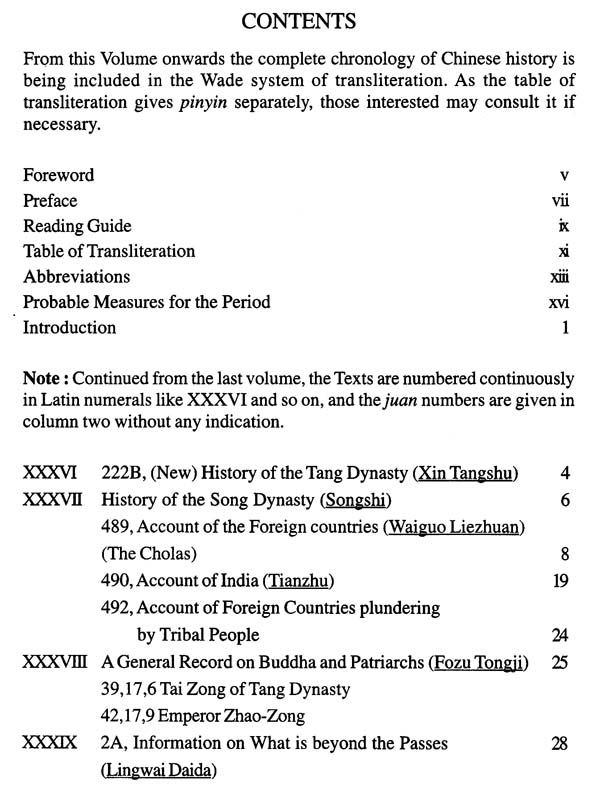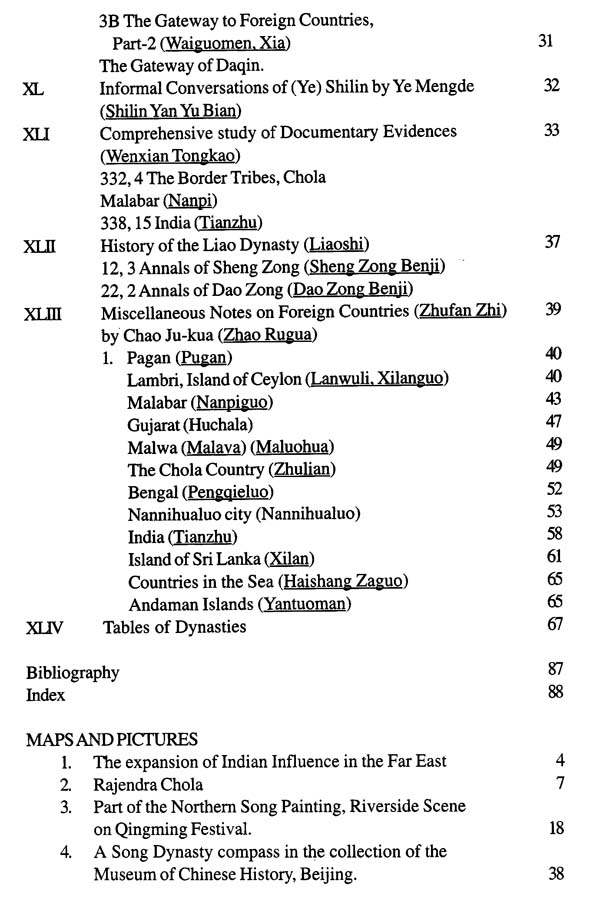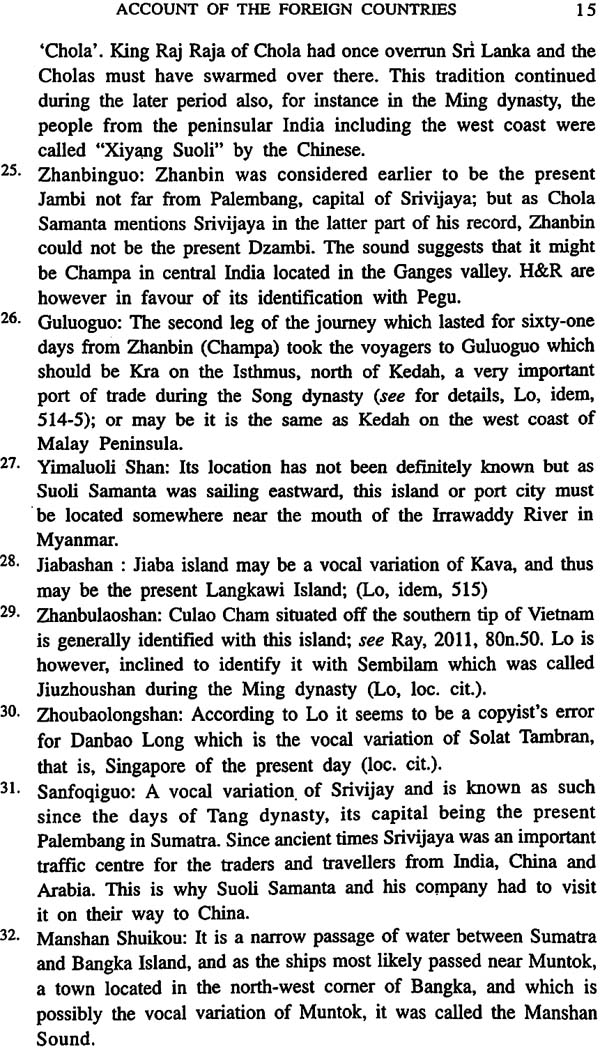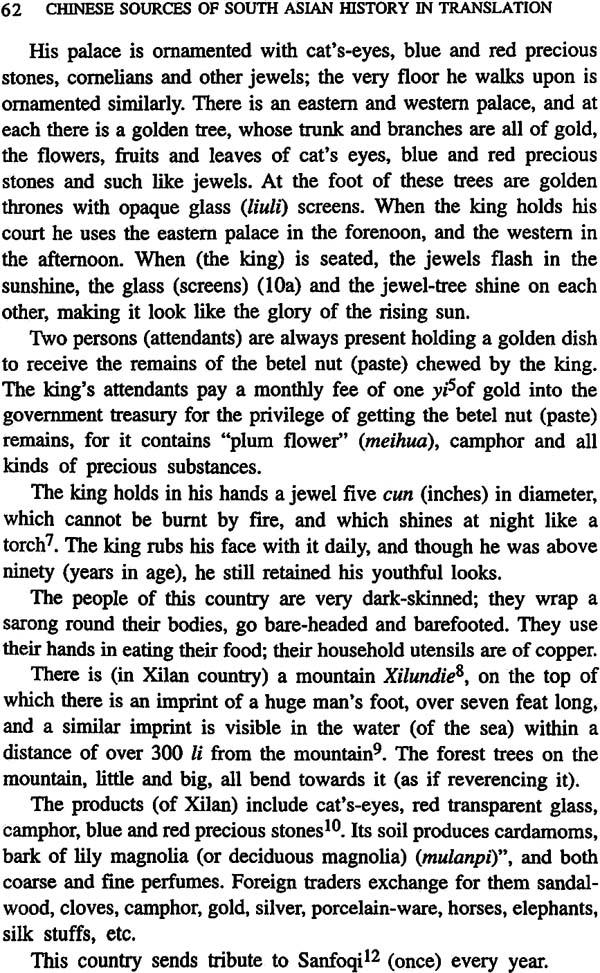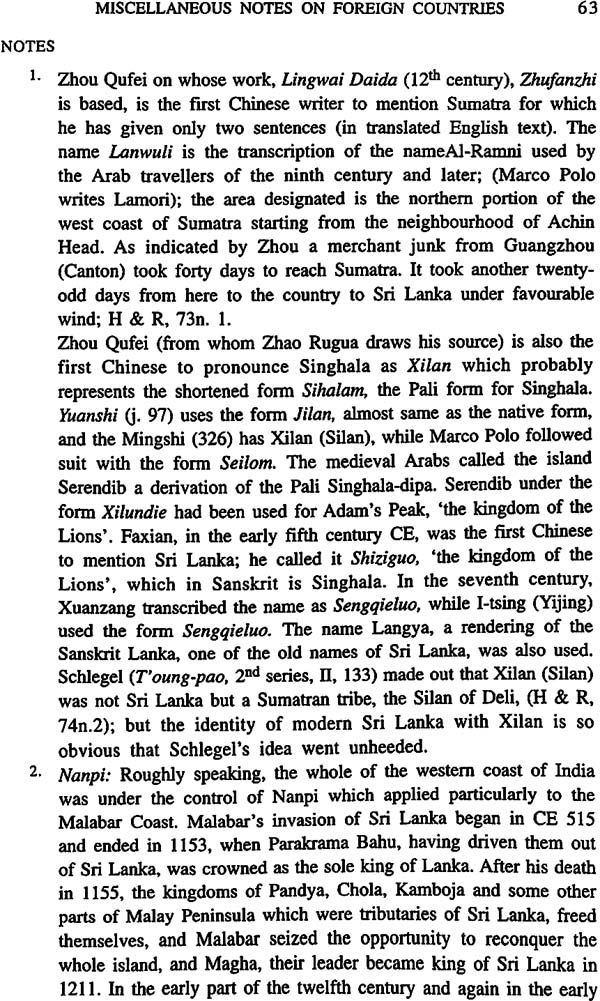
Chinese Sources of South Asian History in Translation- From Religion to Commerce: The Maritime Rendezvous Between India and China, Tenth to Thirteenth Century AD (Vol-VI)
Book Specification
| Item Code: | NAV337 |
| Author: | Haraprasad Ray |
| Publisher: | THE ASIATIC SOCIETY |
| Language: | English |
| Edition: | 2018 |
| ISBN: | 9789381574720 |
| Pages: | 112 |
| Cover: | HARDCOVER |
| Other Details | 8.50 X 5.50 inch |
| Weight | 280 gm |
Book Description
Trade expanded simultaneously with the improvement of Chinese sea-power and handicrafts; quality of silks and porcelain wares was perfected creating world-wide market. The present volume starts with the (New) History of Tang dynasty, and ends with the private historical writings which in many ways supplement the official history, namely Miscellaneous Notes on Foreign Countries (Zhufan Zhi) by Chao Jukua (1226). By this tune we get detailed accounts of inter-state relations between the south Indian state Chola and China. It also contains valuable accounts like Comprehensive study of Documentary Evidences (AD 1322) and other treatises.
The previous volumes of this series have received raving praises and are regarded as valuable sources for the scholars.
The Sixth volume of the series Chinese Sources of South Asian History in Translation has been completed amidst trying condition, but we have not been deterred by adverse situation and finished the job during the schedule period itself and this itself is a matter of great satisfaction and relief for us.
It may be worthwhile to note that Zhulian, the (Chola Country), has been mentioned as Zhunian in some works here for reasons unknown to us, it may be, it was pronounced as such or most of the visitors mistook the word as Zhunian. There are some Indian names like Puyatuoli whose original form we could not trace out.
After the fall of the Tang, trade along the Silk Roads declined, and it revived only with the rise of the Mongols. During this time, China was a "lesser" empire and could neither dominate the nearby oases and towns, nor protect caravans heading westward. In the thirteenth century, the Mongols erupted from Mongolia and created largest contiguous land empire in world history. They conquered and ruled much of the territory through which the Silk Roads traversed and encouraged the greatest flow of merchants, craftmen and missionaries across Eurasia.
During this period in the 10th century and after, Buddhism after reaching its apex in China, has remained stagnant and we do not hear about anything except transport of Buddhist texts from India and neighbouring areas by enthusiastic monks and the records left by them about China, the South-East Asia and Western India in the valuable accounts like Wenxian Tong Kao, Zhufanzhi, Fozu Tongji , Lingwai Daida and so on. We hope the present volume will fulfil the expectation of the scholars and students looking for fresh materials for their research.
Finally I register my grateful thanks to Sri Manik De and Sri Joydip Gupta for their patiently typing out this difficult document of India-China relations.
It gives me immense pleasure in placing the sixth volume of the series entitled Chinese Sources of South Asian History in Translation. Reiterating my observations recorded in the Foreword to the fifth volume, let me add that this volume includes the India-China relations and connected topics. It includes data not only from the official texts like New History of the Tong dynasty and History of Song dynasty but also from the private historical writings like General Account of Buddha and Patriarchs by Chi Pan (compiled between 1258 and 1269) which gives idea about the Chola and Malabar states of India and also China. It also contains valuable details from the Comprehensive study of Documentary Evidences (A.D. 1322) and other treatises.
I believe the scholars across all academic divides especially in social sciences, will accept the volume with the same importance that they have already shown to all the earlier volumes.
As in Han times, the people of Tang controlled communications from China to Central Asia, through the Turkic and the Tufan countries. Along this route, Buddhism with its profound and incalculable influences had begun to pass in the early years of Eastern Han. Now in addition came the three Persian religions-Nestorianism, Zoroastrianism and Manichaeism, called Sanhu 'Three Foreign religions' (Hu i.e. foreigners referring to Persia and Sanhu referring to the above three religions). These religions were welcomed by the Tang rulers and they enlarged and diversified the Chinese arts and conceptions. For the space of some three hundred years, by contact with newly risen tribes, and through them with the mighty empires of India and the Caliphs (Khalifas), Chinese civilization was sown with fresh seeds of greatness.
The Song dynasty was marked by remarkable exploits in arts, religion and philosophy which consisted chiefly in a revaluation of old ideas. China was ready for a new era, and this was to dawn with the Mongol conquest, with the new ideas it brought and especially with the opening up of relations with the Western World. In 1276, Hangzhou, the capital of Song fell, and the Mongols were masters of the largest empire the world had ever known.
As for India's relations with China, there are numerous Chinese records of embassies exchanged between China and the Pallava Court in South India in the eighth century, and the Chola (Cola) court in the eleventh century. A fair amount of trade was carried on between China and India, specially with South India in the following centuries and Chinese junks visited Indian waters quite freely. One of the most valuable notices of the kingdoms of South India in the middle ages is that of Zhao Rugua (Chau Ju-kua), the Chinese inspector of foreign trade, who compiled his work called Zhufanzhi (Chu-fan-chi) about AD 1225. The great Mongol emperor Kublai Khan sent a number of embassies to the south Indian states, some of whom were involved in local politics also. The Chinese merchant Wang Dayuan visited a number of foreign countries for purpose of trade between the years 1330 and 1349, and wrote the Daoyi-zhi-lue; most of the notices concerning South Asia in this work has been translated by us. The work contains no fewer than ninety-nine countries, ports and noteworthy localities. Colombo, the Maldives, Kayankulam, Eli and Calicut (Kozhikotte) are among the places he describes. Most of the accounts in this and other works related to South Asia have been translated by us for the benefit of concerned scholars.
The scope of this volume does not stretch beyond this account of fourteenth century; hence our story for this volume ends here for the time being.
This tome starts with a very short description of the ancient country called Piao which we known today as Myanmar (Myandian in Chinese). The end of the Classic age in China, the Song dynasty, coincided with the rise of Chola dynasty in South India, and we find a detailed picture of our intimate relations (j489, 490) including the history of Song dynasty which gives us a picture of frequent movement of envoys from our country to another and taking away of Indian Buddhist texts to China for which Indian priests, and perhaps also traders in the guise of holy persons are involved. A General record on Buddha and Patriarchs continues the same tradition and goes further like citing the age of Botanluo, a priest, as two hundred and seventy years, and also the glowing of the Stupa of Buddha at Xiling at night (FZTJ.42,17,9). It may be noted here that our comment on the location of Daqin is different from that of the other scholars. However it needs further exploration (LWDD, 2An10, 3Bnl)
The three notices in WXTK are worth comparing with those of Zhao Rugua because of the diverse nature of sources used by both the authors. The interesting comment by the author of WXTK shows that the foreign powers employed highly educated Chinese scholars to communicate with the Chinese emperors (332.4). Zhao Rugua's work Zhufanzhi, though based primarily on earlier works like Lingwai Daida is important for us because of the reliable sources supplied by traders and others who had personally visited the forty-six-odd countries described by the author. We are now ready to move on to the middle of the medieval period where we shall bring our readers face to face with the great naval and un-precedented voyages led by Zheng He and the detailed accounts of China's neighbours in Asia, as far as Africa, and of course, the unprecedented growth of trade and diplomacy with Buddhism peeping at the background. But for that we have to wait for the sub-sequent volumes.
**Contents and Sample Pages**
